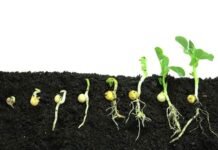In 2013 after completing his secondary education George Muturi decided to venture in vermiculture (rearing of earthworms), a not-so-famous farming activity among Kenyan farmers. This was because he lacked fees to advance to higher levels of education.
The worms rearing idea was sold to him in 2015, two years after trying out in poultry farming, by an officer at International Centre for Insect Physiology and Ecology (ICIPE) when he went to buy black soldier eggs to hatch, raise them to larvae stage and feed his chicken.
Within a portion of family land in Lari, Kiambu County, he would make a structure worth Sh500 before buying some starter worms at Sh2,500 from a fellow farmer.
“This is how cheap I discovered starting off in vermiculture would cost me and I wasted no time,” said Muturi adding that the worms just feed on household or farm wastes which they convert into affordable organic fertiliser called vermicompost that he sells to other farmers for crop production.
“Together with vermiliquid, an organic foliar, the two products are liked by farmers especially those who run kitchen gardens as the dark, rich, earthly smelling fertilizer and foliar amends soils given they are full of both primary and micronutrients readily available to plants,” said the vermiculturist.
Indeed, worm casting also improves the physical property of the soil by improving tilt, ferocity and moisture-holding capacity of the soil according to Dr. Freddie Acosta, a Senior Lecturer of Technology and Innovation Management at Strathmore Business School.
Besides, adding vermicompost and vermiliquid to soil reduces insect pests and plant diseases in a certain field and greenhouse crops including corn, wheat, pea, cucumber, and tomato.

Now, one kilogram of earthworms (approx. 1500 worms) fed very well and given the right moisture and protection from predators at the beginning of January, can multiply and increase their number to approximately 4000 kilograms at the end of December.
After a year of rearing, a farmer can produce up to three tonnes of organic fertiliser every day.
For Muturi, he harvests 100-150 kilos of vermicompost and 80-100 litres of vermiliquid a month. He sells a kilo of vermicompost at Sh70 and a litre of vermiliquid at Sh150 resulting to Sh25,500 a month.
He also sells the 10 kilos of the worms to other farmers every month at Sh2,000 making Sh20,000 a month.
Besides red worms, he has also started domesticating African Nightcrawlers which are also excellent vermicomposting and fishing worms.
He has since started his own startup, Agri-Tech Organic Farm through which he is designing a simple three-in-one vermiculture system for kitchen gardeners using three buckets that enable the farmers to rear the worms and collect vermicompost and vermiliquid in separate buckets.
Only three buckets of twenty litres capacity with wider top and narrow bottom, rabbit manure and five kilos of starter-worms worth Sh2,500 is a good point to start from.
The buckets are inserted into each other in such a way that they do not touch each other at the bottom.
The topmost bucket in which the worms, rabbit manure and fresh organic wastes such as fruit and vegetable remains are placed is covered at the top and some holes made on the upper sides for letting in fresh air.
The worms, rabbit manure and fresh organic wastes are sandwiched with some dry matter materials such as grass on top and bottom. Some holes of considerable sizes are also made at the bottom of this top bucket to allow vermicompost and vermiliquid pass through to the second bucket.
“Rabbit manure is preferable to any type of manure because it speeds up the worms’ reproduction leading to faster decomposition of the wastes for more compost manure and vermiculture liquid,” said Muturi.
The middle or second bucket is where the vermicompost is collected depending on the activity of the worms on the organic wastes and the manure. The bucket too has some smaller holes than the upper one allows vermiliquid from the worms in the top bucket to pass through to the lats or bottom bucket.
The last bucket which is raised some few inches from the ground using some bricks, stones or wood has a tap at the bottom through which vermiliquid is tapped.
Vermicompost accumulated in the second bucket is used as manure for crops while vermiliquid collected in the bottom bucket acts as organic foliar and it is best for crops such as fruits and vegetables as started in the introduction.
Muturi installs the system for other farmers at Sh4,500 for the 20-litre buckets and Sh6,000 for the 50-litre bin.










Am interested
Hi
Am interested
Comments are closed.